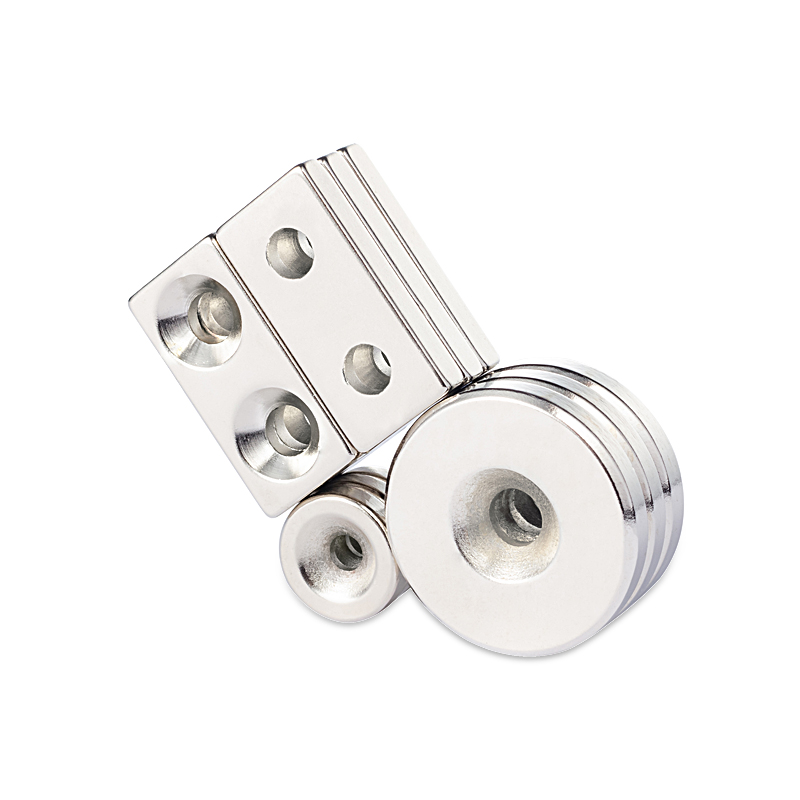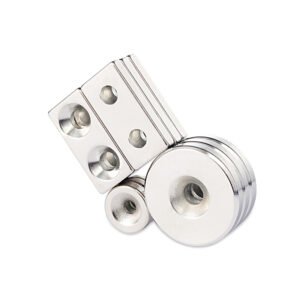
Countersunk Neodymium Magnets
Grades: N35 to N55, plus high-temperature types
Dimensions: specify hole diameters, angles, and positions
Minimum distance: hole major diameter + at least 1 mm margin
Disadvantage: countersunk holes reduce magnet strength and durability
We make countersunk neodymium magnets to allow screws or bolts to be flush with their surfaces. There are at least 3 typical benefits that the countersunk holes can offer.
First, they eliminate the gap between the 2 surfaces that should join by using magnetism and maximize the bonding effects.
Second, countersunk holes can distribute the load of the screws more evenly across the surface of the neodymium magnets – which are fragile – and prevent cracks and breaks due to excessive pressure on specific spots.
Third, this can give a more beautiful appearance, especially if the magnets are visible.
Features of countersunk neodymium magnets
Generally speaking, it is very convenient to fix neodymium magnets on other surfaces using double-sided tapes. Unfortunately, not all surfaces are suitable for using double-sided tapes.
In general, it is best to use double-sided tapes on smooth, non-porous surfaces that are relatively flat and stable. This will help to ensure that the tapes form a strong and durable bond. Meanwhile, there are several surfaces that are not well-suited for using double-sided tape. Therefore, we will make countersunk neodymium magnets for you to fasten them with screws.
Below are some surfaces that are not suitable for double-sided tapes. And you should consider using countersunk neodymium magnets instead for fixing them on these surfaces.
Porous surfaces: They can absorb the adhesive of double-sided tapes – such as wood or concrete – reducing the bonding effects.
Irregular or rough surfaces: They can make it difficult for the tapes to form a reliable bonding effect – such as textured wallpaper or unfinished wood workpieces.
Flexible or stretchy surfaces: They can cause the tapes to lose their grip and come loose in a short time – such as rubber or vinyl surfaces.
Slippery surfaces: They can cause the tapes to slide or shift – such as polished metal or smooth plastic.
Oily or greasy surfaces: They can prevent the tapes from sticking properly – such as metal machinery components.
These types of surfaces can be difficult to work with because they can cause the tape to lose its grip and come loose. Therefore, it’ll be a better choice to fasten the neodymium magnets using screws.
Dimensional identification
The dimensional identifications of countersunk neodymium magnets – are the same as for other shapes. The major difference is you will need to specify the diameters, angles, and positions of the countersunk holes.
Countersunk holes (also called screw holes) include a primary hole and a major hole.
d for the inner diameter
M for the diameter of the major hole
Better to include the countersunk angles
Better to indicate the diameters with exact numbers, rather than general model numbers like M4.
There are the metric units and the imperial units; sometimes the difference can make the screws and holes won’t match.
Available dimensions
You will need to take the sizes of screws into consideration for the hole of countersunk neodymium magnets. Besides that, the available dimensions are the same as for other shapes.
Neither the width nor the length of the magnet can be smaller than the major hole diameter, and better to leave a distance of at least 1 mm. We will need to make chamfers on their edges as well.
Grades
Neodymium magnets have different grades, ranging from N35 to N55, and they also have high-temperature designs for special applications.
You can refer to our introduction to neodymium magnet grades. It will be helpful for you to determine which grade is the most appropriate for you.
Magnetization directions
The magnetization directions of countersunk neodymium magnets will remain the same as their bodies without the countersunk holes. No special consideration for the designs with holes.
Suppose you need a disc neodymium magnet with a hole in the center, the magnetization directions will be the same as the disc without this hole.
Coatings
It’s important to apply proper surface treatment to neodymium magnets. There are multiple options available, depending on your specific applications.
Generally speaking, neodymium magnets with countersunk holes will work with another component. This means they are usually hidden or even covered. You can consider the coatings that have better cost-effectiveness.
Optional designs
How do we assure the quality of countersunk holes
When making countersunk holes in metal, there are several things to be careful about. We need to avoid damaging the magnets. Below are some tips that we keep in mind to offer the best countersunk holes.
Use drill bits of the right sizes for the countersunk holes in the right order. One special consideration is to make a comparatively large hole on a small surface. If you use a large drill bill to make the hole in one step, the neodymium magnets are fragile, and they may crack. So, we prefer to use a small drill bit first and then use the big one.
Keep the drill bits sharp. If a drill bit is dull or damaged, it can cause the hole to be uneven or jagged, and even leave burs on the edge. This will have a negative impact on the function and appearance of the countersunk holes.
Use low speeds for the drills to prevent neodymium magnets from overheating. High–speed drilling can cause the neodymium material to heat up and become brittle. High temperatures are negative for neodymium magnets.
Overall, it is important to be careful when making countersunk holes in neodymium magnets. Osenc always tries our best to make sure the holes will not bring negative impacts.
Factors determining quality of countersunk holes
Countersunk holes look simple but that doesn’t mean we don’t need to pay attention to their quality. There are multiple factors contributing to the quality of countersunk holes in neodymium magnets. Some of the most important factors include:
The diameters and angles: Countersunk holes should have correct diameters and angles to fit the screws that will be used. If the holes are too small, you can’t insert the screws smoothly. If the holes are too big, the magnets may shift a little bit. If the angles are not right, fastening the screws can make the magnets crack or break.
The positions: The holes should be accurately positioned in neodymium magnets. In this way, you will be able to insert the screws straight into the magnetic assemblies. If the holes are not aligned properly, this can cause the screws to bind or be difficult to assemble.
The smoothness: The edges should be smooth and have no burrs or rough spots. These minor defects can cause screws to bind or reach the correct positions.
The depth: The depth of the holes must be correct for the length of the screws. The holes should be deep enough for you to fully insert the screws, so they may not cause gaps between the magnet surfaces and magnetic assemblies.
Osenc people will do our best to assure the quality of countersunk holes. So, they meet these criteria, and they will function properly in the finished products.
Disadvantages of magnets with countersunk holes
The major advantage of making countersink holes in neodymium magnets is to replace the double-sided tapes for fixing and positioning the magnets. However, this also has a disadvantage as well – countersinking holes would weaken the magnets’ magnetism and mechanical strength.
Making countersunk holes in neodymium magnets reduces the material of the magnet. That will decrease its magnetic strength.
Instead of countersinking holes in neodymium magnets, people typically use other methods to attach them to a surface, such as adhesive or other mechanical fasteners.
Where to buy?
Contact us today to get a quote for countersunk neodymium magnets.
Osenc can manufacture it to fit your exact specifications.
Always more than happy to help you determine the best solution for your applications.
